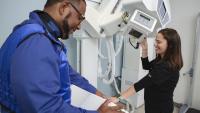ColumbiaDoctors Midtown Radiology Diagnostic Imaging Center

Make an Appointment
Request an appointment by phone or online. View our locations.
Columbia Radiology pairs the highest level of diagnostic imaging expertise with the latest technology available today to provide our patients with expert exams in a safe environment.
All of our radiologists are fellowship-trained faculty at Columbia University Irving Medical Center—leaders in their field who help establish radiology standards and protocols used worldwide.
We welcome new patients!
SERVICES
Magnetic Resonance Imaging (MRI)
Magnetic resonance imaging (MRI) is an imaging procedure utilizing strong magnetic fields and radio waves to produce cross-sectional images of organs and internal structures in the body.
Magnetic Resonance Angiography (MRA)
A form of MRI called magnetic resonance angiography (MRA) is an MRI that focuses on blood vessels and blood flow. MRA is most commonly used to identify aneurysms and blockages of blood vessels in the head, neck, chest, abdomen, or extremities.
PET/CT
PET is often combined with CT (computed tomography) in a dual-purpose PET-CT imaging device. The scans are done simultaneously and can be viewed separately or as a single, overlapping "fused" PET-CT image. The two individual techniques present different types of information:
- PET shows metabolic or chemical activity in the body
- CT shows the body's anatomical structures
Computed Tomography (CT)
Computed tomography (CT) (sometimes called "computerized tomography" or "computed axial tomography" (CAT)), is an X-ray exam that uses specialized equipment to produce cross-sectional images of the body.
Digital Mammography
Mammography, a technique that uses a low dose of X-rays to image the breast, is an important tool in detecting breast disease.
Bone Densitometry (DEXA)
The most advanced form of bone densitometry, DEXA (dual energy X-ray absorptiometry), is a non-invasive and painless X-ray test of the spine, hip, and arm bones that gives doctors precise information about the amount of calcium in the bones.
Ultrasound
Ultrasound imaging uses sound waves with a frequency above the range audible to the human ear—“ultrasound”—to create images of internal organs, structures, and tissues.
X-Ray/Fluoroscopy
Fluoroscopy is an X-ray imaging technique doctors use to observe both the structure and function of organs including the bladder, kidneys, reproductive organs, and parts of the GI tract.
